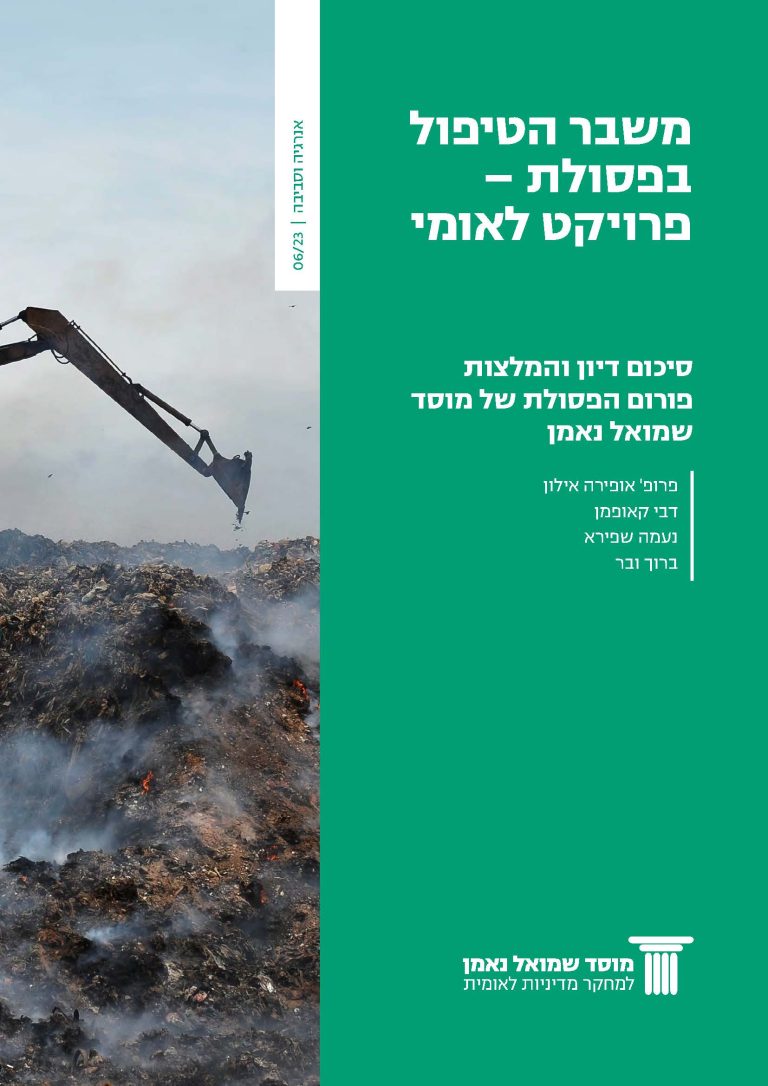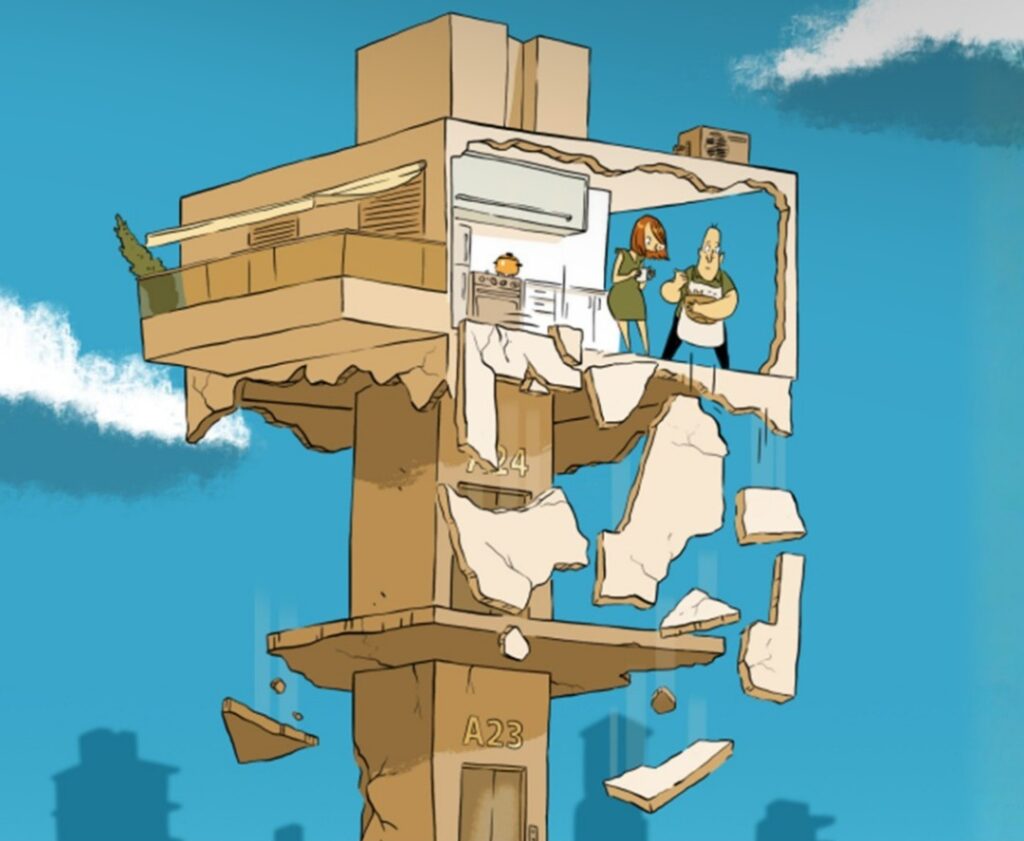בשנים האחרונות מדינת ישראל הגיעה למשבר פסולת ממשי. הן דו”חות מבקר המדינה שהתפרסמו בשנים 2021 ו-2022, והן דו”חות המפל”ס, שהתפרסמו בשנים האחרונות היו אמורים זה מכבר, להדליק נורת אזהרה נוכח משבר זה, המלווה בפליטת החלק הארי של החומרים המסרטנים לאוויר במדינה, כמו גם אחוז ניכר מגזי החממה, בעיקר מתאן.
זאת ועוד, גם דירוגה של ישראל במדדים סביבתיים שונים מעידים על ישראלה כמדינה נחותה בטיפול הסביבתי שלה. כך למשל באינדקס EPI שנחשב מקובל ב-OECD ובעולם, לבחינת ניתוח המדינות במדדי הסביבה השונים, ישראל ממוקמת רק במקום ה-57 אחרי מדינות הרבה פחות מתקדמות ממנה, כמו נמיביה, בולגריה, רומניה ועוד. בנושא חיוניות מדיניות המערכת האקולוגית שלה והאקוסיסטם הסביבתי, הכוללים משאבי מים, חקלאות ושירותי סביבה שונים ישראל נדחקת למקום ה-98.
על פי הלשכה המרכזית לסטטיסטיקה, בשנת 2017 הסתכמה כמות הפסולת שנוצרה בישראל בכ-20.9 מיליון טונות. הפסולת השנתית מתפלגת כדלהלן: כ-8.2 מיליון טונות פסולת יבשה, כ-6.8 מיליון טונות פסולת מעורבת, כ-5.5 מיליון טונות פסולת חקלאית, כ-0.3 מיליון טונות פסולת מסוכנת וכ-0.1 מיליון טונות בוצה. כ-45% מהפסולת שנוצרה מקורה במשקי הבית והמסחר (5.4 מיליון טונות) ובתעשייה (3.9 מיליון טונות).
בשנת 2019 יוצרו בישראל כ-5.8 מיליון טון של פסולת עירונית מוצקה, כאשר למעלה מ-40% ממנה מיוצרים במחוזות מרכז ותל אביב. מסקר הרכב הפסולת הארצי 2012-2013 פסולת שנערך בשנת 2013 על ידי חברת שחף והמשרד להגנת הסביבה, ב-27 רשויות, עולה כי הפסולת העירונית במשאיות הדחס מורכבת מ-32% שאריות מזון, 22% נייר וקרטון, 17% פלסטיק ו-29% אחר. חשוב לציין שאין עדיין נתונים מעודכנים לשנת 2022, אבל סביר להניח שנתוני הפסולת בעת כתיבת דו”ח זה מדאיגים יותר, שכן כפי הפסולת בישראל אינה מטופלת כהלכה והיא ממשיכה להצטבר בכל יום שעובר.
במסמך, המציג רטרוספקטיבה של הטיפול בפסולת עירונית מוצקה בישראל בשנים 2007-2022, מוצג הפער בין המדיניות אותה חרט המשרד על דגלו בנושא מדיניות הטיפול בפסולת מוצקה ובין הביצועים בשטח.
מכאן שנושא הטיפול בפסולת בישראל, ללא ספק דורש נקיטת פעולות מיידיות, שכן מדובר בפצצת זמן מתקתקת. ממסקנות דיון פורום הפסולת שנערך כאמור על בסיס מסמך “משבר הטיפול בפסולת בישראל דחוף יותר מהטיפול במשבר האקלים”, עלה נושא מרכזי בולט והוא מתקני הקצה לטיפול בפסולת כאשר בעקבות הדיון נכתבו ההמלצות להלן:
- הגדרת הטיפול בפסולת כפרויקט לאומי – הגדרת הטיפול בפסולת כפרויקט לאומי הכולל שיתוף כל בעלי העניין בשוק הפסולת, מנגנון ניהול תקציב, ייזום והקמת מתקני קצה לטיפול בפסולת.
- הפרדת הטיפול בשינויי האקלים מהטיפול בפסולת – ההתמודדות עם נושא האקלים אינה אמורה לעכב את הטיפול בפסולת, ובטח לא את מי שאמון על כך. אמנם הפסולת והטיפול בה נכללים באותה קטגוריה בשל ההשפעה הדו צדדית של שני נושאים אלו אחד על השנייה, אך יש חובה מוסרית וסביבתית ליצור הפרדה בין שני התחומים בעיקר בכל הנוגע לטיפול בפסולת.
- הגדרת גוף (רשות או מנהלת) אשר יוסמך לניהול הטיפול בפסולת – מוצע להקים מנהלת משותפת של המשרד להגנת הסביבה והשלטון המקומי לניהול הפסולת, בדומה לרשות המים ותאגידי המים והביוב (או מודל אחר שייבחן ויימצא מתאים). יש לשקול לכלול במנהלת גם גופי טיפול בפסולת, כגון איגוד ערים דן לתברואה ודודאים, אשר נמצאים בבעלות חלקית של רשויות מקומיות). המנהלת תכין תוכנית רב שנתית, לרבות מדדי ביצוע, ליישום מדיניות המשרד להגנת הסביבה (והממשלה בכלל), ולטובת עמידת הרשויות המקומיות באחריות לטיפול בפסולת. מכיוון שמדובר במנהלת אשר משותפת למשרד גם המדיניות תתבצע בהסכמה משותפת, ובהתאם לתוכנית הרב שנתית. בדומה לתאגידי המים והביוב, המנהלת תורכב מאנשי מקצוע בתחום, מהנדסים וכלכלנים אשר יתוו מדיניות ארוכת טווח. המשרד להגנת סביבה, בדומה למשרד האנרגיה והתשתיות ביחס לתאגידי המים והביוב, יהיה הרגולטור.
- משק פסולת סגור – מנהלת הטיפול בפסולת תהיה גוף ביצועי, ומשק הפסולת יתנהל כמשק כלכלי סגור. תקציבי המנהלת יגיעו משני מקורות עיקריים – תאגידי פסולת אזוריים יגבו את עלות הטיפול בפסולת בשלטון המקומי (תשלומים ייעודיים לטיפול בפסולת, באמצעות תשלום ישיר בגין הפסולת המיוצרת, ולא כחלק מהארנונה). מקור נוסף יהיה כספי היטל ההטמנה אשר בקרן לשמירת הניקיון, באופן שיבטיח ניצול כספי הקרן למטרה אשר לשמה הוקמה. בזכות תנאי פתיחה מצוינים של כספים בקרן לשמירת הניקיון, וכן הכנסות שנתיות של למעלה מ-600 מיליון ₪, יש היתכנות להחלה מיידית של התהליך.
- מדיניות פסולת ארוכת טווח – יש צורך בחשיבה ארוכת טווח לפסולת ולכן מוצע כי הטיפול בפסולת יונהג ל-20 שנה לפחות קדימה, על מנת לאפשר יציבות ובניית מתקנים בהשקעות גדולות, למשל במודלים של BOT או PPP שיאפשרו לקדם את שוק הפסולת.
חשוב לציין כי נושאים כמו צמצום במקור, התאמת הפתרון ל”אגן ההיקוות” (יישום עקרון הסמיכות), מרחקי שינוע ועוד, הם מעבר להיקף הדיון, אך יש לתת עליהם את הדעת בגיבוש הפתרון הכולל, וכחלק מהתוכנית הרב שנתית שעל מנהלת הפסולת להכין.












